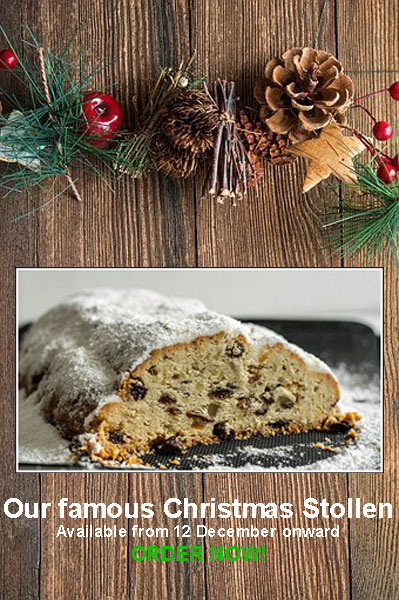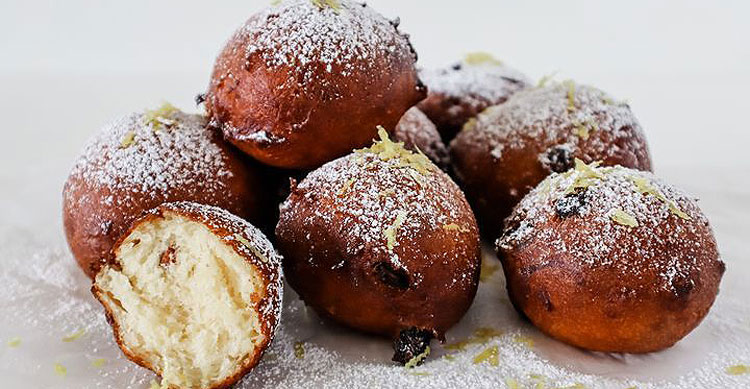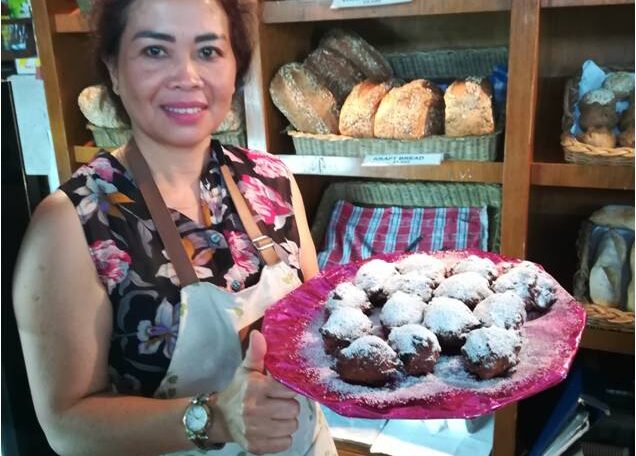Oliebollen with apple and raisins
After a long dry spell, we can again offer our customers, especially our Dutch customers, our delicious Oliebollen at the turn of the year.
Our Oliebollen Quality with candied fruits, raisins and apple 12.000 IDR p. piece
An Oliebol (Dutch pronunciation) Oliebollen. West Frisian: Oaljebol or Oaljekoek is a traditional Belgien and Dutch beignet
(Beignet is a type of donut or fried pastry, usually made with yeast dough in France, possibly made with pâte à choux and called pets-de-nonne, nun’s fart, in France, but can also be made with other types of dough, including yeast dough. In France there are many different versions of it, at least 20. They can vary in shape, the flour used in the dough and the filling. It is popular in French, Italian, and French-American cuisines.)
They are called oliebollen or smoutballen in the Nederlands, smoutebollen in Flanders and croustillins in Wallonia.
Oliebollen are a type of dumpling, made by scooping a specified amount of batter using an ice cream scoop or two spoons and placing the batter in a deep fryer filled with hot oil. This creates a spherical oliebol. They are traditionally eaten on New Year’s Eve and at county fairs. In winter, they are also sold at mobile stands on the street.
The dough consists of flour, eggs, yeast, some salt, milk, baking powder and usually sultanas, raisins or succaden (candied fruits). A notable variety is the apple fritter, which contains only a slice of apple, but unlike oliebollen, the dough should not rise for at least an hour. They are usually served with powdered sugar.
The origins are not entirely clear. They are said by some to have been first eaten by Germanic tribes in Belgium and the Netherlands during the Yule, the period between December 26 and January 6 where such baked goods were used.
It has also been speculated that they were introduced to the Netherlands in the 15th century by Portuguese Sephardi Jewish immigrants; the food being related to the Jewish sufganiyah traditionally eaten on Hanukkah.
The earliest discovered recipe of oliekoecken (“oil cookies”, the direct precursor of the oliebol) came from the 1667 Dutch book De verstandige kock “The sensible cook”.
The contest
From 1993 to 2017 Dutch newspaper Algemeen Dagblad has held an annual highly publicized oliebollentest at the end of each year. In 2012, the bakery of Willy Olink from Maarssen won the test.
In 2013 Richard Visser won the test for the ninth time in twenty years which is currently the record for the highest number of wins by one person.
The test stopped in 2018 after it appeared that the jury and the writers of the reviews were not the same people and the articles in the newspaper didn’t reflect the reality and were exaggerated .
Fans of the treat continued reviewing oliebollen from all over the country by themselves, compiling their ratings on a website.




